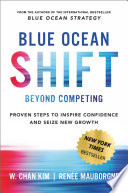Blue Ocean Shift
by W. Chan Kim, Renee Mauborgne
Concepts
1. Understanding Market Creation
Market creation does not have to mean a disruption or destruction of existing markets. In our complete Blue Ocean Shift summary, we elaborate on 3 key market-creation approaches, each with a different mix of disruptive vs non-disruptive creation.
The key is to focus on value innovation, not technological innovation or entrepreneurship. A blue ocean comes from unparalleled buyer value, not new technology. Starbucks and the Grameen Bank are examples of new markets created without new technology. You don’t need to be an entrepreneur to create a new market. All you need are the proper tools and processes to (i) translate innovation into buyer value and (ii) help people to overcome their fears and inertia.
2. The Blue Ocean Mindset
Use these 4 guiding principles to break free from a red ocean mindset and open up new blue ocean possibilities:
• Your existing industry boundaries and conditions aren’t fixed. You can shape and transform the boundaries—you’re only limited by your imagination.
• Don’t focus on beating your rivals. Seek to make your competition irrelevant by delivering a quantum leap in value. Ask yourself: how can we deliver such a compelling offering that we’d win masses of buyers even without marketing? This forces you to rethink the bases of your competition and investment.
• Don’t fight over existing customers. Focus on creating and capturing new customers, which unlocks a much larger untapped demand or market.
• Don’t choose between low cost or differentiation. Create superior value by offering both low cost and differentiation.
3. Humanness
People want to make an impact, yet they’re afraid to fail. Adopt a humanistic approach: give people inspiration, confidence and direct their creative energy with 3 elements.
• Atomization: A big leap to a blue ocean can seem daunting. Instead, break it down into tiny, specific steps that people can grasp and execute to achieve quick wins.
• Firsthand discovery: If you tell people to change, they’ll resist. Instead, create the conditions where people will discover for themselves the need for change. Give them the tools to arrive at the conclusions themselves, and get them out on the field so they can see/experience the buyers’ pain points and alternatives.
• Fair Process: This involves 3 principles to develop trust and cooperation: (i) engagement (actively involving people in the process), (ii) explanation (helping people to understand the rationale for each step) and (iii) clear expectations (giving clarity on roles, responsibilities and what to expect).
Equip people with specific tools and frameworks (using the 5-step process below) to direct their creative competence.
